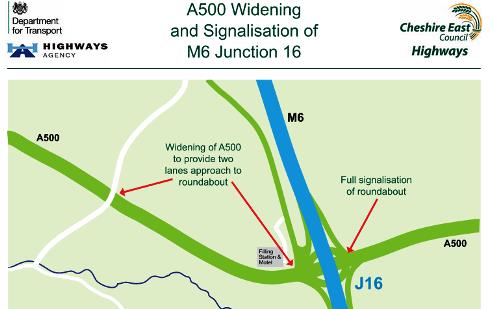
Nantwich drivers are being warned about major works about to start on the A500 on the approach to the M6.
Work is starting on multi-million pound road improvements scheme designed to improve traffic between Crewe and Nantwich and the motorway.
Vegetation clearance is being carried out on the verge and roundabout area near to junction 16, before work starts on widening a 600m stretch of the A500.
It is a joint scheme between Cheshire East Council and the Highways Agency that will see traffic signals on Junction 16 roundabout and widening of the A500 to two lanes approaching the junction from Crewe and Nantwich.
This will taper into a short third lane at the roundabout in a bid to ease congestion at the junction which often tails back all the way to the A5020 roundabout at Weston.
Funding was agreed by the Department for Transport’s (DfT) “pinch point” programme and the project will be managed by the Highways Agency.
The scheme is due to start early in June, and to be completed by Christmas.
It means construction work will be carried out under a 50mph speed limit restriction and some overnight closures.
Cllr Michael Jones, Leader of Cheshire East Council, said: “This scheme is the culmination of several years of hard work and lobbying and is the latest in a series of successful road bids to deliver better connectivity and jobs-led, plan-led growth for the people of Cheshire East.
“One of our key aims is for Cheshire East to have a strong and resilient economy and improving the roads in and around the borough ensures we will gain an even greater reputation as an excellent place to do business.”
Recent funding bids by Cheshire East include £7.5m for improving junction 16 and widening of the A500 on the approach, £2.7m of towards the Basford West spine road linking the A500 at Shavington with Gresty Road in Crewe, and up to £15.7m for the Crewe Green Link Road scheme.





















Recent Comments